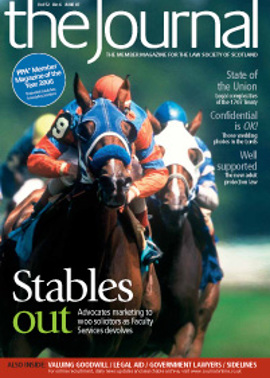Public and confidential

It was not the presence of Danny Devito, Jack Nicholson or Anthony Hopkins that gave the wedding of Michael Douglas and Catherine Zeta Jones notoriety amongst the readership of this magazine, but a Mr Rupert Thorpe. Mr Thorpe was a freelance photographer and it is not clear how he managed to mix it (in modern parlance) with the family and glitterati at New York’s Plaza Hotel on 19 November 2000.
Prior to their wedding the happy couple had agreed with the publishers of OK! Magazine that they would give them the exclusive rights to publish wedding photographs that they had approved. They were paid £1 million. That will have gone some way to offset the costs of the event and the handsome tip that it is reported the groom left for the hotel staff. It was agreed that the Douglases would arrange for photographers to be at the event. Tight security was organised, hotel staff were vetted and it was made clear to the invited guests that no one other than the official photographer would take photographs.
Mr Thorpe managed to breach the security, however, and obtained some illegitimate images which he sold to Hello! magazine the following day. It is reported that about 15,000 copies of Hello! were distributed before OK! managed to obtain an interim order preventing the sale of the rest of the print run of approximately 750,000 copies. That order was lifted soon afterwards and the illegitimate photographs made their way onto the newsstands alongside the OK! edition, the publication of which was brought forward.
The road to the Lords
The publishers of OK!, Northern and Shell plc, alongside Michael Douglas and Catherine Zeta Jones, sued the publishers of Hello!, alleging breach of confidence and also that they had caused loss by unlawful means. At first instance, the couple were awarded modest damages for the distress and damage they each suffered. The court also found that there had been a breach of confidence, and OK! was awarded just over £1 million in damages.
While upholding the relief granted to the Douglases, the Court of Appeal overturned OK!’s judgment, saying that the obligation of confidence that OK! enjoyed extended only to the photographs that the couple authorised OK! to publish and not to the unauthorised ones taken by Mr Thorpe.
The case then found itself in the House of Lords and on 2 May their Lordships issued their judgment, Douglas and Another and others v Hello! Ltd and others [2007] UKHL 21, ruling that Hello! had indeed breached OK!’s confidentiality rights (albeit that Hello! had not knowingly injured OK!’s business and thus was not liable for all legal costs).
Their Lordships’ judgment did not concern the case brought by the Douglases, who dropped out of proceedings at the Court of Appeal stage with their award intact. While therefore avoiding the thorny “privacy” issues touched on by the lower courts, the result of OK!’s appeal to the House of Lords ostensibly represents a significant development in the law of confidence across the UK.
The confidentiality test
So what of the law? Well, there are three criteria for a breach of confidence, as stated by Megarry J in Coco v A N Clark (Engineers) Ltd [1969] RPC 41:
(1) the information must have the necessary quality of confidence about it;
(2) the information must have been imparted in circumstances importing an obligation of confidence; and
(3) there must have been an unauthorised use of that information to the detriment of the party communicating it.
According to the Coco case, in applying this test, the law of confidentiality “ought not to be invoked merely to protect trivial tittle-tattle”. It is also generally accepted that if information is put into the public domain and thus ceases to be secret, the obligation of confidence ceases (at least where confidentiality is not lost due to unauthorised disclosure by the recipient).
Considering the Coco test in the past, it may have seemed relatively unlikely that photographs of newlyweds eating cake could be regarded as confidential, particularly when other photos of said newlyweds (and their cake) had already been published. How then did their Lordships conclude that the Coco criteria had been met?
Applying the test
Some of their Lordships struggled to accept that photographs of a celebrity wedding, especially where the bride and groom did not want the images to remain secret but intended them to be published in a magazine such as OK!, could attract the quality of confidence. However, in the leading judgment by Lord Hoffmann, the earlier High Court finding was affirmed, it being felt that there was no difficulty in such photographs attracting an obligation of confidence where there was a publisher prepared to pay a significant sum to be the only source of published images. In assessing what is “trivial tittle-tattle”, this ruling would therefore appear to suggest that commercial value is key.
The majority of their Lordships also found that the fact that OK!’s photographs were already in the public domain (insofar as they had been published a few hours earlier) did not mean that Hello! had not breached an obligation of confidence. The fact that the Douglases had got married, the dress the bride wore, the cake the guests ate and so forth may have been in the public domain, but it was felt that each photograph of the event should be treated as containing a separate piece of information. Lord Hoffmann implied that as the differences between the photographs in the public domain and those taken by Mr Thrope had commercial value, the new information conveyed must be capable of protection under the law of confidence.
It being well known that the obligation of confidence was imposed for the benefit of OK! as well as the Douglases, their Lordships accordingly supported the earlier High Court decision.
What is being protected?
Has this case, as some commentators have held, created protection for personality or image rights? The leading judgment by Lord Hoffmann asserted that this was not the case. He found that the fact that the information in question was about the Douglases’ private life was not relevant.
In his dissenting judgment, Lord Walker warned that the nature and not the market value of information was the relevant factor in determining whether the law of confidence should provide protection. However, Lord Hoffmann felt that what was important was that the information had commercial value over which the Douglases had sufficient control to enable them to impose an obligation of confidence.
While the two sets of photographs were similar, Lord Hoffmann’s finding appears to have been based on the premise that the Hello! photographs disclosed information not previously disclosed in the OK! photographs, and that these “secrets” should be seen as more than mere trivial tittle-tattle, because they were apparently commercially valuable.
Was this really the case in reality? As sole licensee, the law of copyright effectively gave OK! exclusive rights over the official photographs. Had these been the only photographs, OK! would have had a monopoly over photographic coverage of the wedding. One could argue that it was not in fact the differences in the photographs which had commercial value, but the ability to break the monopoly effected under the law of copyright, which had real commercial value in this case. Their Lordships questioned why Hello! was willing to pay so much for information already in the public domain. Perhaps the answer is not because the information they sought to publish was different, but rather because the law of copyright prevented Hello! from providing OK!’s “public domain” information to Hello!’s own readers. This was not however the view expressed by the majority of their Lordships.
A blurred line
The Lords’ decision would, on the face of it, appear to provide significantly increased additional protection to celebrities and organisers of events (and their contractors who have been granted coverage rights) to that already provided under intellectual property law. With their Lordships split 3-2, where exactly the line has been drawn is not entirely clear. Nevertheless, practitioners would do well to remember that irrespective of whether information is a “trade secret”, where such intellectual assets have commercial value, the law of confidence should at least be considered, in addition to copyright and trade mark protection.Ewan McIntyre is Head of Litigation, and Iain Wisely a senior solicitor in the Corporate Department, at Morton Fraser LLP
In this issue
- Court plans with little appeal
- Winning ways
- Forward steps
- Bar to progress
- Dean urges solicitors to stay with fee scheme
- The Union and the law
- Public and confidential
- Adult support: a new generation
- Advice deserts and PDSOs
- Vision 20:20
- Benevolent Fund: a much valued support
- Termites in the basement
- The value of goodwill
- Letters of Engagement Roadshow
- A door almost shut
- Lessons in improvements
- Null from the outset?
- The Tevez affair
- Scottish Solicitors' Discipline Tribunal
- Website reviews
- Book reviews
- Held in check
- Possession undisturbed






